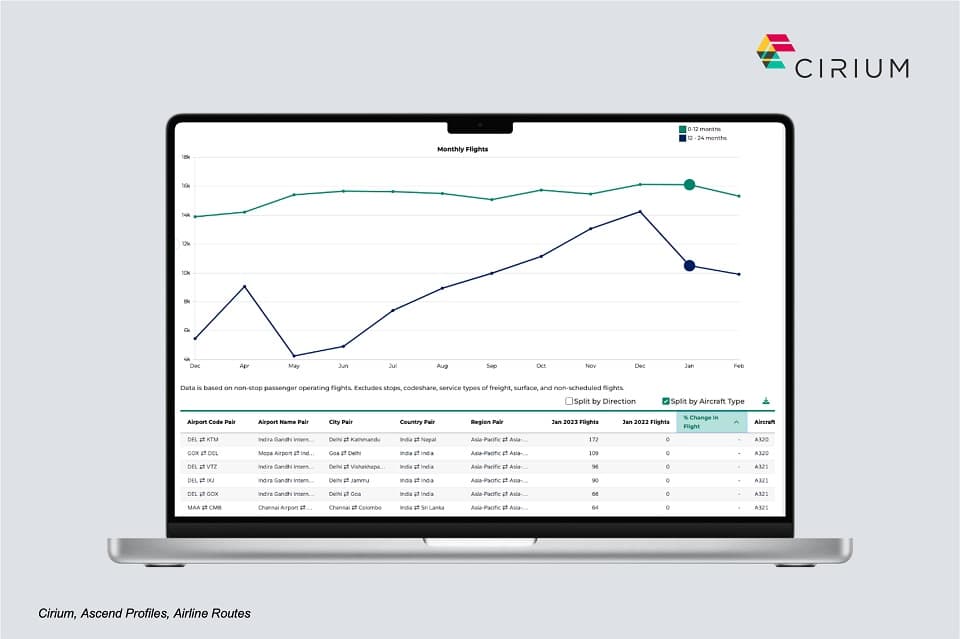Aerospace
Cirium Launches the First Airline Routes Tool Based on Satellite-Based Flight Tracking

Cirium, the aviation analytics leader, has launched the aviation industry’s first Airline Routes tool to identify actual flights flown by aircraft type.
10 best airlines in the world for on-time performance 2022.(Opens in a new browser tab)
It uses applied analytics to derive routes flown by airlines based on satellite-based flight tracking and fuses this with advanced fleet data. The new premium Routes tool is part of Ascend Profiles, a visual descriptive analytics tool which enables businesses to quickly view aircraft intelligence by airline or lessor.
Businesses such as aircraft lessors, banks or aircraft manufacturers are empowered to identify the aircraft flown by route for 1,700 airlines and factor development opportunities or risk into their decision-making. By leveraging satellite-based flight tracking data the tool identifies what routes and aircraft airlines actually flew rather than what they planned to fly providing the most accurate flight completion picture.
India is one of the markets in the spotlight currently, as air travel is helping to boost economic growth in the region. Low-cost-carrier, IndiGo recently announced it was looking to grow its international network and further solidify its domestic operations. According to Ascend Profiles, IndiGo has a fleet of 306 aircraft – (273 in service and 33 in storage), plus 501 on order. Of the delivered fleet, 36% are on operating lease.
Boeing Awarded U.S. Army Contract for Next Generation Diagnostic Tool(Opens in a new browser tab)
The Routes tool shows which two-way international routes IndiGo was operating this January which it was not in January 2022. For example, 172 flights were tracked on the newly added route between Indira-Gandhi International Airport in Delhi to Tribhuvan International in Kathmandu. All operated using Airbus A320s.
Additionally, the new tool shows the bi-directional routes for which IndiGo has ramped up operations. The carrier saw the most significant growth on the Singapore – Bengaluru route, where it completed 62 flights, all using A320s, this January versus only one flight, using an A321, last January.
IndiGo also substantially increased its operations this year on the Dubai – Ahmedabad route, completing five times the number of flights in Jan 23 when compared with Jan 22. The Airline Routes tool is part of Ascend Profiles which visualizes aircraft intelligence of airline or lessor profiles and provides quick and accurate insights showing the latest 12-month year-over-year flights flown by an airline’s routes and can be viewed by flights, seats and ASKs. The tool is available as a web-app on desktop, tablet, and mobile.

Aerospace
Boeing Transfers Rocket Stage to NASA, Paving Way for Human Moon Mission

Boeing has achieved a significant milestone by providing NASA with the second core stage of the Space Launch System (SLS) rocket.
This crucial component, crafted at NASA’s Michoud Assembly Facility (MAF), is set to propel the Artemis II crew into lunar orbit, marking humanity’s return to deep space after a 50-year hiatus.
The monumental Boeing-built rocket stage, the largest element of the Artemis II mission, will embark on a journey aboard the Pegasus barge, traveling 900 miles to NASA’s Kennedy Space Center.
Comparison of two legendary aircraft B777x vs B747 aircraft:Click here
Upon arrival, it will be meticulously integrated with other essential Artemis II components, including the upper stage, solid rocket boosters, and NASA’s Orion spacecraft within the iconic Vehicle Assembly Building. This intricate integration process is a vital step toward the eagerly anticipated Artemis II launch, slated for 2025.
“Boeing-built products helped land humankind on the moon in 1969, and we’re proud to continue that legacy through the Artemis generation,” remarked Dave Dutcher, vice president and program manager for Boeing’s SLS program. “Together, with NASA and our industry partners and suppliers, we are building the world’s most capable rocket and paving the way to deep space through America’s rocket factory in New Orleans.”
NASA, Lockheed Martin Reveal X-59 Quiet Supersonic Aircraft:Click here
The delivery of Core Stage 2 marks a significant achievement in the evolution of the SLS rocket. Towering over 200 feet and powered by four RS-25 engines, this core stage, coupled with two solid-fueled booster rockets, will generate a staggering 8.8 million pounds of thrust. This immense power is crucial to launching Artemis II and future missions into the vast expanse of space.
The SLS rocket stands unparalleled in its capability to transport both crew and substantial cargo to the moon and beyond in a single launch. Its extraordinary capacity will facilitate the delivery of human-rated spacecraft, habitats, and scientific missions to destinations including the moon and Mars, ushering in a new era of space exploration.
-

 Travel1 week ago
Travel1 week agoAir India to Expand US Operations with Three New Routes After a Decade
-

 Travel2 weeks ago
Travel2 weeks agoWhy We Should Avoid These Stamps in a Passport
-

 Airlines1 month ago
Airlines1 month agoInvestigations Reveal Fake Chinese Titanium in Boeing and Airbus Jets
-

 Tech4 weeks ago
Tech4 weeks agoChina’s CATL Plans 1,800-Mile Electric Plane Launch by 2027
-

 Airport3 days ago
Airport3 days agoTop 10 Largest Airports in the World by Size
-

 Aerospace4 weeks ago
Aerospace4 weeks agoChina’s Fighter Jets Turn Wings into Autonomous Drones
-

 Airlines4 days ago
Airlines4 days agoAir India Rolls Out A350s for Delhi-New York JFK and Newark Routes
-

 Defence3 weeks ago
Defence3 weeks agoBoeing Enhances Chinook with New Engines and Block II Upgrades at $96 Million








